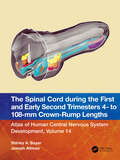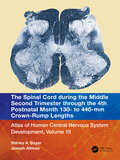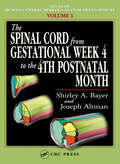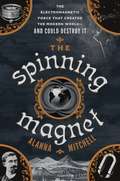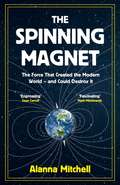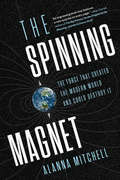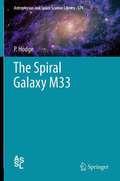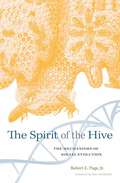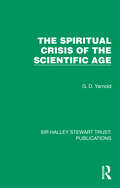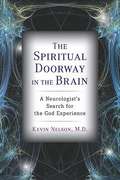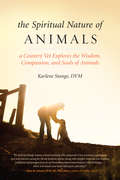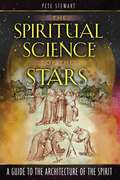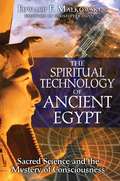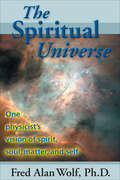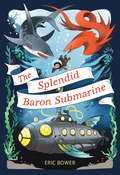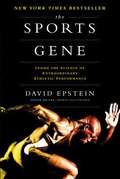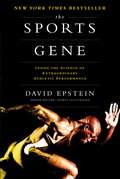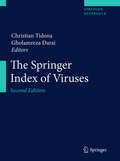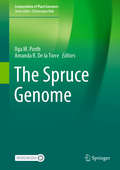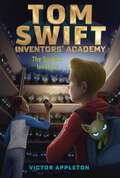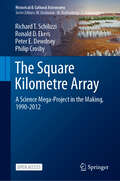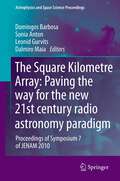- Table View
- List View
The Spinal Cord during the First and Early Second Trimesters 4- to 108-mm Crown-Rump Lengths: Atlas of Human Central Nervous System Development, Volume 14
by Shirley A. Bayer Joseph AltmanThis fourteenth of 15 short atlases reimagines the classic 5 volume Atlas of Human Central Nervous System Development. This volume presents sections of the spinal cord from specimens between 4 mm and 108 mm with detailed annotations. Extensive 3-D reconstructions show the early development of the germinal zones, the earliest neurons and early white matter accumulations at cervical levels only. Other 3-D reconstructions in older specimens show the progressive segregation of motor neuron columns at all levels in the ventral gray. The Glossary (available separately) gives definitions for all the terms used in this volume and all the others in the Atlas.Key Features Classic anatomical atlases Detailed labeling of the structures in the developing spinal cord offers updated terminology and the identification of unique developmental features, such as germinal matrices of specific neuronal populations and migratory streams of young neurons Appeals to neuroanatomists, developmental biologists, and clinical practitioners A valuable reference work on brain development that will be relevant for decades
The Spinal Cord during the Middle Second Trimester through the 4th Postnatal Month 130- to 440-mm Crown-Rump Lengths: Atlas of Human Central Nervous System Development, Volume 15
by Shirley A. Bayer Joseph AltmanThis last of 15 short atlases reimagines the classic 5 volume Atlas of Human Central Nervous System Development. This volume presents serial sections of the spinal cord from specimens between 130 mm and 440 mm with detailed annotations. The presentation of these specimens emphasizes the sequence of myelination in various fiber tracts.The Glossary (available separately) gives definitions for all the terms used in this volume and all the others in the Atlas.Key Features Classic anatomical atlases Detailed labeling of structures in the developing spinal cord offers updated terminology and the identification of unique developmental features, such as myelination gliosis and gradients of myelination in the spinal cord white matter Appeals to neuroanatomists, developmental biologists, and clinical practitioners A valuable reference work on brain development that will be relevant for decades
The Spinal Cord from Gestational Week 4 to the 4th Postnatal Month (Atlas of Human Central Nervous System Development)
by Shirley A. Bayer Joseph AltmanThis first volume in the Atlas of Human Central Nervous System Development series sets the stage with complete coverage of the spinal cord from gestational week 4 to the 4th postnatal month. 3D color images provide a holistic view of the structural changes during spinal cord morphogenesis. This landmark first volume provides quantitative summaries of several ontogenetic trends. It features all the stages of spinal cord development, offers fresh insights into the steps involved in the morphogenesis of the mature spinal cord, and shows the human spinal cord at its most primitive stage, when consisting mainly of neuroepithelial stem cells. This atlas is also available as part of the complete five volume series.
The Spinning Magnet: The Electromagnetic Force That Created the Modern World--and Could Destroy It
by Alanna MitchellThe mystery of Earth's invisible, life-supporting powerAlanna Mitchell's globe-trotting history of the science of electromagnetism and the Earth's magnetic field--right up to the latest indications that the North and South Poles may soon reverse, with apocalyptic results--will soon change the way you think about our planet.Award-winning journalist Alanna Mitchell's science storytelling introduce intriguing characters--from the thirteenth-century French investigations into magnetism and the Victorian-era discover that electricity and magnetism emerge from the same fundamental force to the latest research. No one has ever told so eloquently how the Earth itself came to be seen as a magnet, spinning in space with two poles, and that those poles have dramatically reversed many time, often coinciding with mass extinctions. The most recent reversal was 780,000 years ago.Mitchell explores indications that the Earth's magnetic force field is decaying faster than previously thought. When the poles switch, a process that takes many years, the Earth is unprotected from solar radiation storms that would, among other disturbances, wipe out much and possible all of our electromagnetic technology. Navigation for all kinds of animals is disrupted without a stable, magnetic North Pole. But can you imagine no satellites, no Internet, no smartphones--maybe no power grids at all?Alanna Mitchell offers a beautifully crafted narrative history of surprising ideas and science, illuminating invisible parts of our own planet that are constantly changing around us.
The Spinning Magnet: The Force That Created the Modern World – and Could Destroy It
by Alanna MitchellMany times through deep history Earth&’s magnetic poles have switched places, leaving our planet&’s protective shield weaker and life vulnerable to devastating solar storms. The last time it happened was 780,000 years ago, long before humans emerged, but it won&’t be long until it happens again. And when it does, will it send us back to the Stone Age? The Spinning Magnet is a fascinating insight into what may lie ahead. From the pivotal discoveries of Victorian scientists to the possibility of solar radiation wiping out power grids, and the secrets of electromagnetism, Alanna Mitchell reveals the truth behind one of the most powerful forces in the universe.
The Spinning Magnet: The Force that Created the Modern World and Could Destroy It
by Alanna MitchellOur future might be a world without electronics or protection from lethal solar radiationThe magnetic North Pole will eventually trade places with the South Pole. Satellite evidence suggests to some scientists that the move has already begun, but most still think it won't happen for many decades. All agree that it has happened many times before and will happen again. But this time it will be different. It will be a very bad day for modern civilization. Award-winning science journalist Alanna Mitchell tells in The Spinning Magnet the fascinating history of one of the four fundamental physical forces in the universe, electro-magnetism. From investigations into magnetism in 13th century feudal France and the realization six hundred years later in the Victorian era that electricity and magnetism were essentially the same, to the discovery that the earth was itself a magnet, spinning in space with two poles and that those poles aperiodically reverse, this is an utterly engrossing narrative history of ideas and science that readers of Stephen Greenblatt and Sam Kean will love. But the recent finding that the Earth's magnetic force field is decaying ten times faster than previously thought, portending an imminent pole reversal, ultimately gives this story a spine tingling urgency. When the poles switch, a process that takes many years, the Earth is unprotected from solar radiation storms that would, among other things, wipe out all electromagnetic technology. No satellites, no internet, no smart phones--maybe no power grid at all. Such potentially cataclysmic solar storms are not unusual. The last one occurred in 2012 and we avoided returning to the dark ages only because the part of the sun that erupted happened to be facing away from the Earth. One leading US researcher is already drawing maps of the parts of the planet that would likely become uninhabitable.
The Spiral Galaxy M33
by P. HodgeThis book summarizes the gathering of information on and the growing understanding of M33 from the 1920s, when Hubble first determined its true nature, to the 21st century, when the Hubble Telescope probed deeply into its many secrets. With its regular symmetrical spiral structure, and its being not tilted too much and near enough to allow detailed studies of its stars, M33 is well-suited for the study of a typical spiral galaxy. In this work, Paul Hodge places current research on M33 (and similar galaxies) in both historical and global perspectives. The book is written in a language accessible for specialists and non-specialists, for professional and amateur astronomers, for scientists and the curious public and, most importantly, for students.
The Spiral Galaxy M33 (Astrophysics and Space Science Library #379)
by P. HodgeThis book summarizes the gathering of information on and the growing understanding of M33 from the 1920s, when Hubble first determined its true nature, to the 21st century, when the Hubble Telescope probed deeply into its many secrets. With its regular symmetrical spiral structure, and its being not tilted too much and near enough to allow detailed studies of its stars, M33 is well-suited for the study of a typical spiral galaxy. In this work, Paul Hodge places current research on M33 (and similar galaxies) in both historical and global perspectives. The book is written in a language accessible for specialists and non-specialists, for professional and amateur astronomers, for scientists and the curious public and, most importantly, for students.
The Spirit of the Hive
by Robert E. Page Jr.How can 40,000 bees working in the dark, by instinct alone, construct a honey comb? Synthesizing decades of experiments, The Spirit of the Hive presents the genetic and physiological mechanisms underlying the division of labor in honey bee colonies and explains how it is an inevitable product of group living, evolving over millions of years.
The Spiritual Brain: A Neuroscientist's Case for the Existence of the Soul
by Denyse O'Leary Mario BeauregardDo religious experiences come from God, or are they merely the random firing of neurons in the brain? Drawing on his own research with Carmelite nuns, neuroscientist Mario Beauregard shows that genuine, life-changing spiritual events can be documented. He offers compelling evidence that religious experiences have a nonmaterial origin, making a convincing case for what many in scientific fields are loath to consider—that it is God who creates our spiritual experiences, not the brain. Beauregard and O'Leary explore recent attempts to locate a "God gene" in some of us and claims that our brains are "hardwired" for religion—even the strange case of one neuroscientist who allegedly invented an electromagnetic "God helmet" that could produce a mystical experience in anyone who wore it. The authors argue that these attempts are misguided and narrow-minded, because they reduce spiritual experiences to material phenomena. Many scientists ignore hard evidence that challenges their materialistic prejudice, clinging to the limited view that our experiences are explainable only by material causes, in the obstinate conviction that the physical world is the only reality. But scientific materialism is at a loss to explain irrefutable accounts of mind over matter, of intuition, willpower, and leaps of faith, of the "placebo effect" in medicine, of near-death experiences on the operating table, and of psychic premonitions of a loved one in crisis, to say nothing of the occasional sense of oneness with nature and mystical experiences in meditation or prayer. Traditional science explains away these and other occurrences as delusions or misunderstandings, but by exploring the latest neurological research on phenomena such as these, The Spiritual Brain gets to their real source.
The Spiritual Crisis of the Scientific Age (Sir Halley Stewart Trust: Publications)
by G. D. YarnoldFirst published in 1959, the original blurb reads: “No good purpose is served today by treating the relationship between Christianity and the natural sciences as a conflict; even as a conflict to be resolved. The modern world is passing through a crisis of far-reaching proportions; which is the direct consequence of its inability to assimilate new scientific knowledge, and to direct rightly the new technical skills. The crisis, which is essentially spiritual in character, is examined in its three principal aspects. Accordingly, the first part of the book deals with our understanding of the order of nature; the second with some of the central doctrines of the Christian faith; and the final section with the pressing ethical and moral problems of the industrial and nuclear age.” Today it can be read and enjoyed in its historical context.This book is a re-issue originally published in 1959. The language used and views portrayed are a reflection of its era and no offence is meant by the Publishers to any reader by this re-publication.
The Spiritual Doorway in the Brain
by Kevin Nelson"Bold, provocative, and highly readable. "-V. S. Ramachandran, M. D. , author of Phantoms in the Brain What are near-death experiences, out-of-body sensations, and spiritual ecstasy? And what do they have in common? Perhaps no one is more qualified to answer these questions than renowned neurobiologist Dr. Kevin Nelson. Drawing on his more than three decades of groundbreaking research into the "borderlands of consciousness," Dr. Nelson offers an unprecedented journey into the site of spiritual experience: the brain. Filled with amazing firsthand accounts as varied as a patient seeing the devil battling with his guardian angel to a man watching the universe synchronize around a pinball machine, The Spiritual Doorway in the Brain is an eloquent examination of our brains' spiritual "hardwiring" that will enthrall believers and skeptics alike. .
The Spiritual Nature of Animals: A Country Vet Explores the Wisdom, Compassion, and Souls of Animals
by Karlene StangeBeloved Companions, Kindred Spirits Karlene Stange’s spiritual journey began as she drove her pickup loaded with medical supplies to attend to animals throughout southwestern Colorado, where the Animas River carves the landscape. As an ambulatory veterinarian, she has experienced the challenges, sorrows, and joys of working with creatures great and small and feels a powerful kinship with these beautiful beings, a bond that goes beyond flesh and fur and feathers. The Spiritual Nature of Animals chronicles her amazing exploration through the teachings of various religious and cultural traditions, as well as her encounters with the magnificent Rocky Mountain terrain and the quirky characters — both animal and human — who inhabit it.
The Spiritual Science of the Stars: A Guide to the Architecture of the Spirit
by Pete StewartThe profound influence of ancient cosmologies on our ideas about the human spirit • Shows how ancient myths contain a sophisticated understanding of our relationship to the cosmos, derived from thousands of years of observation of the night sky • Explains how ideas of the mind and spirit are still entwined with these ancient cosmologies despite the disruptive effects of modern astronomy • Reveals how ancient ideas and contemporary cosmology might be combined into a new model for spiritual meaning Thousands of years before the first written records, humans were turning to the night sky as a source of meaning for existence and their place within it. The conclusions drawn from these observations are embodied in stories from across the world known as Creation Myths. Contrary to the popular belief that these myths were meant to explain the origins of the universe, Pete Stewart shows that they were actually designed to create a harmony and order in the lives of humans that reflected, in their society and architecture, the ordered patterns they saw evidenced in the sky. These ancient myths also record, in the story of “the separation of Heaven and Earth,” the discovery of a disastrous discord in this ancient harmony, which the mythmakers overcame by imagining a vastly expanded architecture, one in which the individual soul had a role to play in the evolution of the cosmos.Today science presents a similar challenge to our sense of meaning. Stewart explores how, by reexamining the myths of creation in this light, we can learn how contemporary cosmology might yield a new architecture for the spirit and how the ancient sense of being in the cosmos might be reconstructed for our age.
The Spiritual Technology of Ancient Egypt: Sacred Science and the Mystery of Consciousness
by Christopher Dunn Edward F. MalkowskiHow ancient Egyptians understood quantum theory • Investigates the history of how modern religion and the Age of Science were inspired by the sacred science of the ancients • Examines how quantum theory explains that the cosmos arises from consciousness • Reveals the unanimity between Schwaller de Lubicz’s “sacred science” and the science of a cosmos governed by quantum mechanics Since the dawn of the Age of Science humankind has been engaged in a methodical quest to understand the cosmos. With the development of quantum mechanics, the notion that everything is solid matter is being replaced with the idea that information or “thought” may be the true source of physical reality. Such scientific inquiry has led to a growing interest in the brain’s unique and mysterious ability to create perception, possibly through quantum interactions. Consciousness is now being considered as much a fundamental part of reality as the three dimensions we are so familiar with. Although this direction in scientific thought is seen as a new approach, the secret wisdom of the ancients presented just such a view thousands of years ago.Building on René A. Schwaller de Lubicz’s systematic study of Luxor’s Temple of Amun-Mut-Khonsu during the 1940s and ’50s, Edward Malkowski shows that the ancient Egyptians' worldview was not based on superstition or the invention of myth but was the result of direct observation using critical faculties attuned to the quantum manifestation of the universe. This understanding of reality as a product of human consciousness provided the inspiration for the sacred science of the ancients--precisely the philosophy modern science is embracing today. In the philosophical tradition of Schwaller de Lubicz, The Spiritual Technology of Ancient Egypt investigates the technical and religious legacy of ancient Egypt to reveal its congruence with today’s “New Science.”
The Spiritual Universe: One Physicist's Vision of Spirit, Soul, Matter, and Self
by Fred Alan WolfFrom a National Book Award winner, “methodical and clear . . . provides physics-phobics a wide bridge to understanding some often arcane material” (Booklist).Why do we believe in the soul? Does it actually exist? If so, what is it? Does it differ from the self? Does it survive the body after death? In The Spiritual Universe, Fred Alan Wolf brings the most modern perspective of quantum physics to the most ancient questions of religion and philosophy. Taking the reader on a fascinating tour of both Western and Eastern thought, Wolf explains the differing view of the soul in the works of Plato, Aristotle, and St. Thomas, the ancient Egyptian’s belief in the nine forms of the soul, the Qabalistic idea of the soul acting in secret to bring spiritual order to a chaotic universe of matter and energy, and the Buddhist vision of a “nonsoul.” Wolf then mounts a defense of the soul against its modern critics who see it as nothing more than the physical body.“One of the few pathfinders who have discovered the versatility and potency of the new quantum paradigm based on consciousness.” —Amit Goswami, Professor of Physics and author of The Self-Aware Universe“The questions are exhilarating and the conclusions are properly mysterious and profoundly inconclusive . . . you’ll love the spirited journey.” —Thomas Moore, author of Care of the Soul and The Re-Enchantment of Everyday Life“Wolf is a new Thales for a new physics of the soul; his book will blow your mind and quicken your spirit.” —Michael Grosso, Ph.D., author of The Millennium Myth and Frontiers of the Soul
The Splendid Baron Submarine (The Bizarre Baron Inventions #2)
by Eric Bower"The Splendid Baron Submarine is delightfully absurd, imaginative, and fun—a wonderful book for middleschool children to read on their own, and an even better book for families to read aloud together." - Foreword Reviews, Starred ReviewPirate treasure? A top secret mission? A terribly rude monkey with personal boundary and hygiene issues? Two out of three of those things sound like a dream come true to the young, clumsy, and terribly unscientific Waldo “W.B.” Baron, when his clever inventor parents are hired to go on a secret treasure hunt. The Baron family dives into adventure with their steam-powered submarine, but they aren’t prepared for the complications that occur during their trip, which include shark attacks, deep sea diving mishaps, and even a pirate’s curse, all of which W.B. is lucky enough to discover, one stumble, trip, and fall at a time.
The Sports Gene
by David EpsteinThe New York Times bestseller - with a new afterword about early specialization in youth sports. The debate is as old as physical competition. Are stars like Usain Bolt, Michael Phelps, and Serena Williams genetic freaks put on Earth to dominate their respective sports? Or are they simply normal people who overcame their biological limits through sheer force of will and obsessive training? In this controversial and engaging exploration of athletic success and the so-called 10,000-hour rule, David Epstein tackles the great nature vs. nurture debate and traces how far science has come in solving it. Through on-the-ground reporting from below the equator and above the Arctic Circle, revealing conversations with leading scientists and Olympic champions, and interviews with athletes who have rare genetic mutations or physical traits, Epstein forces us to rethink the very nature of athleticism.
The Sports Gene: Inside the Science of Extraordinary Athletic Performance
by David EpsteinNow a "New York Times" Bestseller. "In high school, I wondered whether the Jamaican Americans who made our track team so successful might carry some special speed gene from their tiny island. In college, I ran against Kenyans, and wondered whether endurance genes might have traveled with them from East Africa. At the same time, I began to notice that a training group on my team could consist of five men who run next to one another, stride for stride, day after day, and nonetheless turn out five entirely different runners. How could this be?" We all knew a star athlete in high school. The one who made it look so easy. He was the starting quarterback and shortstop; she was the all-state point guard and high-jumper. "Naturals. " Or were they? The debate is as old as physical competition. Are stars like Usain Bolt, Michael Phelps, and Serena Williams genetic freaks put on Earth to dominate their respective sports? Or are they simply normal people who overcame their biological limits through sheer force of will and obsessive training? The truth is far messier than a simple dichotomy between nature and nurture. In the decade since the sequencing of the human genome, researchers have slowly begun to uncover how the relationship between biological endowments and a competitor's training environment affects athleticism. Sports scientists have gradually entered the era of modern genetic research. In this controversial and engaging exploration of athletic success, "Sports Illustrated" senior writer David Epstein tackles the great nature vs. nurture debate and traces how far science has come in solving this great riddle. He investigates the so-called 10,000-hour rule to uncover whether rigorous and consistent practice from a young age is the only route to athletic excellence. Along the way, Epstein dispels many of our perceptions about why top athletes excel. He shows why some skills that we assume are innate, like the bullet-fast reactions of a baseball or cricket batter, are not, and why other characteristics that we assume are entirely voluntary, like an athlete's will to train, might in fact have important genetic components. This subject necessarily involves digging deep into sensitive topics like race and gender. Epstein explores controversial questions such as: Are black athletes genetically predetermined to dominate both sprinting and distance running, and are their abilities influenced by Africa's geography? Are there genetic reasons to separate male and female athletes in competition? Should we test the genes of young children to determine if they are destined for stardom? Can genetic testing determine who is at risk of injury, brain damage, or even death on the field? Through on-the-ground reporting from below the equator and above the Arctic Circle, revealing conversations with leading scientists and Olympic champions, and interviews with athletes who have rare genetic mutations or physical traits, Epstein forces us to rethink the very nature of athleticism.
The Sports Gene: Inside the Science of Extraordinary Athletic Performance
by David EpsteinThe New York Times bestseller - with a new afterword about early specialization in youth sports.The debate is as old as physical competition. Are stars like Usain Bolt, Michael Phelps, and Serena Williams genetic freaks put on Earth to dominate their respective sports? Or are they simply normal people who overcame their biological limits through sheer force of will and obsessive training?In this controversial and engaging exploration of athletic success and the so-called 10,000-hour rule, David Epstein tackles the great nature vs. nurture debate and traces how far science has come in solving it. Through on-the-ground reporting from below the equator and above the Arctic Circle, revealing conversations with leading scientists and Olympic champions, and interviews with athletes who have rare genetic mutations or physical traits, Epstein forces us to rethink the very nature of athleticism.
The Springer Index of Viruses
by Christian Tidona Gholamreza DaraiThe continuous growth of knowledege makes it very difficult for scientists to retrieve comprehensive and accurate data on viruses. The desired information is often dispersed in a variety of books, journals and online resources. This encyclopedia presents the latest facts about all known virus in a standardized form created by hundreds of the world's leading virologists. Virus taxonomy represents the basic framework that allows an understanding of the complex evolutionary process that continuously takes place among viruses and their hosts. Each of the 300 taxonomically ordered chapters includes detailed information on individual genus members, historical events, the hosts they can affect (animal, man or plant), virion morphology, genome properties, replication strategy, properties of individual transcripts and proteins, sequence accession numbers, biological properties, diseases, recombinant vector constructs, vaccine strains, key references, as well as a high-resolution particle image and a drawing of the genome organization. Its high content of easily accessible detail information makes this Encyclopedia an indispensable tool for both researchers and lecturers. The new edition includes the recent discoveries made in this field as well as new viruses which have been discovered.
The Spruce Genome (Compendium of Plant Genomes)
by Ilga M. Porth Amanda R. De la TorreThis book offers comprehensive information on the genomics of spruces (Picea spp.), naturally abundant conifer tree species that are widely distributed in the Northern Hemisphere. Due to their tremendous ecological and economic importance, the management of forest genetic resources has chiefly focused on conservation and tree improvement. A draft genome sequence of the 20-gigabase Norway spruce genome was published in the journal Nature in 2013. Continuous efforts to improve the spruce genome assembly are underway, but are hindered by the inherent characteristics of conifer genomes: high amounts of repetitive sequences (introns and transposable elements) in the genome and large gene family expansions with regards to abiotic stress, secondary metabolism and spruces' defense responses to pathogens and herbivory. This book presents the latest information on the status of genome assemblies, provides detailed insights into transposable elements and methylation patterns, and highlights the extensive genomic resources available for inferring population genomics and climate adaptation, as well as emerging genomics tools for tree improvement programs. In addition, this volume features whole-genome comparisons among conifer species, and demonstrates how functional genomics can be used to improve gene function annotations. The book closes with an outlook on emerging fields of research in spruce genomics.
The Spybot Invasion (Tom Swift Inventors' Academy #5)
by Victor AppletonTom and his friends get to the bottom of a practical joke gone wrong in this fifth novel in Tom Swift Inventors&’ Academy—perfect for fans of The Hardy Boys or Alex Rider.It&’s another day at the Swift Academy when Tom starts finding little troll-like figures around campus. And he&’s not the only one. Much to the amusement and curiosity of students, these dolls are appearing all over the school. But even after they&’re collected by faculty, a second wave mysteriously appears—except these replacements record audio and play it back for surrounding listeners. Before everyone knows it, secrets and gossip are revealed across campus, and suddenly the figures aren&’t nearly as fun as they used to be. What seemed to start as a practical joke quickly turns into something more serious when yet another wave of more advanced robots infiltrates the school. And these record and project video footage. It seems that no one is safe from the spybots as the academy spirals into mayhem, and it&’s up to Tom and his friends to track down the culprit behind the invasion.
The Square Kilometre Array: A Science Mega-Project in the Making, 1990-2012 (Historical & Cultural Astronomy)
by Ronald D. Ekers Richard T. Schilizzi Peter E. Dewdney Philip CrosbyThe Square Kilometre Array (SKA) is a grand vision project to build the most sensitive radio telescope in the world. This open access book tells the story of its development – a story of transformational science, innovative engineering, and global collaboration. Its journey has been long and complex, reflecting the many issues faced in creating an affordable design, choosing a site, and developing a viable global organisation starting from a simple working group of far-sighted and persistent astronomers in 1993.The book begins with the emergence of the SKA concept and the first working group. It traces the development of global scientific and engineering collaborations and ever more comprehensive governance structures for the SKA, the involvement and roles of funding agencies and governments, and the long, political site selection process. This occurred alongside efforts to overcome technical barriers and the difficult process of selecting technology. It follows these themes up to the point in 2012 when the project had just transitioned from a collaboration to a legal entity and the dual site decision was made – a pivotal moment when it was clear the SKA arrays would be built. The book is based on the authors’ personal experience at the leading edge of the project over many years, as well as access to hitherto unpublished material from project archives, interviews, and presentations from many of the key players at a specially convened conference. It has a Foreword written by John Womersley, former Chair of the Agencies SKA Group and SKA Organisation Board. The book is intended for an audience ranging from funding agencies and governments involved in major research infrastructures, to historians of science and professional researchers studying mega-projects, to the astronomy and physics communities in general and interested lay readers.
The Square Kilometre Array: Paving the way for the new 21st century radio astronomy paradigm
by Sonia Anton Domingos Barbosa Dalmiro Maia Leonid Gurvits: The Square Kilometre Array (SKA) will provide more than one order of magnitude improvement in sensitivity compared with any existing radio telescope over a wavelength range of several hundred to one, from decametric to microwave wavelengths. It will revolutionize the study of the most abundant element in the Universe, hydrogen, from the epoch of reionisation to the present-day, probing the onset formation period of the very first stars, will closely scan proto-planets and, through the precision timing of pulsars, will detect the distortions of space-time due to gravitational radiation. The SKA is a sensing network spanning 3000 km from its centre and with a collecting area of more than 1 square kilometre, using technologies of the 21st century. The SKA will make the study of a wide range of phenomena initially studied at other wavelengths possible at radio wavelengths, as well as opening a new discovery window on new phenomena at radio wavelengths. Symposium 7 of the JENAM 2010 aimed at bringing these diverse opportunities to the attention of both theoretical and observational astronomers working at all wavelengths, including the potential for synergies with other facilities. The meeting highlighted the scientific potential of the SKA, discussed scientific priorities and their impact on the design of the SKA, explored the synergies between the SKA and other next-generation astronomical facilities in different wavelength domains such as the ALMA, ELTs, LSST, JWST, GRE, IXO, Gaia and Euclid, and high-energy facilities (Auger), explored the "cyber-infrastructure" that may become available for the distribution and distributed analysis of SKA data.
